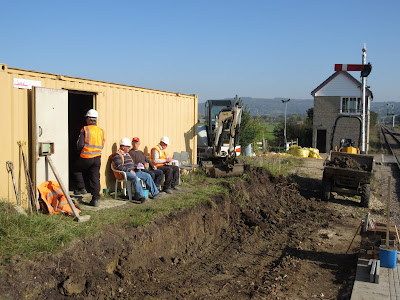60 more tons of chippings were delivered today. Last time, they arrived at about hourly intervals, giving us the chance to deal with each delivery in turn, but today they all arrived at once!
First of all we sought to dispose of the remainder of the rubble which was left over from the platform back filling. While we were loading this, the lorries began to arrive and almost swamped us in chippings.
There was only one dumper today, so was it a toss of the coin to see who would go first? No, John S, ever polite, kindly offered your blogger first dibs.
This it turned out was not so much kindness, as cunning. The dumper seat was split, exposing the foam squab to rain. So much so, that there was moss growing on it. Sit on the seat, even on a dry day, and you press out the water and absorb it into your backside. Damned!
So here we are, this is where the remainder of the back fill went, along the recently dug in edging, where the infill was seen to be low.
There was some unhappiness further down, where the chippings crew were unemployed, and waiting for material. Better get a move on then.
As the dumper controls are a bit temperamental, the fill was raked out with a shovel, as otherwise it would come out all in a rush, and moving it by hand then was difficult, as it doesn't shovel well due to all the brick and concrete bits in it..
Here is John O on the shovel - we had a request for more pictures of him (he has been away a couple of times for domestic reasons).
Here is John again. If you don't want to work too hard, get a smaller shovel. Yes, we have a toy size one, and John has secured it, leaving the hard work with the man sized one to new recruit Peter.
The chippings gang split themselves into two - one group spread out the material as it arrived to aproximately the right depth, while the second group slowly raked the gauge across the infill, adding or subtracting material as necessary, until it was just the right depth, and perfectly level.
After a while JC came to see how far they were getting, as the 60T pile shrank to about half mid morning.
The rail car came and paid us another visit. Last week wasn't, as we all thought, an S&T members only private outing, but a preliminary PWay inspection to determine where the tamper, due shortly, could best be employed.
What was the rail car doing today then?
It was slowly unreeling a large drum of signal cable.
This links the box with the far away signals to the south.
Due to this week's absence of our chief milk and Swiss mini rolls supplier, yours truly was mandated to acquire same. There was a last minute request for cake from Peter - why, was not clear, but we don't need a special reason to eat cake, any day is cake eating day - and great was his pleasure when a chocolate cake duly emerged from the shopping bag.
Here Peter displays the prize. That's the happiest we've seen him all day !
There was a willing band of men happy to share it, including Neil C and Andy P from the rail car cable laying duties. The aroma apparently carries right over to platform one!
Everything stops for cake.
While consuming said cake, we noticed the manufacturer in 1989 of the rails here - glory days indeed, when Britain still ruled the waves. Who will supply us now?
Given the ever shortening distance between mini digger and coal face, we actually finished the chippings infill today, enabling this view of the nearly completed platform two. Running in board, lamp posts, infill, 200 meters of brick wall. We can be proud of that, quite an achievement. Just the path to the L/C to go, and tarmac.
Here is the view at the end of the day. Sorry about the low sun, it's that time of year now. But you can see that the chippings have been completed to the end of the platform, and a pile of material has been dumped at the end for the gang still busy giving the materiual its final level.
A last picture of John O, a portrait even.
We are being entertained with a joke.
And the punchline is? It's on the tip of the tongue, I knew it a minute ago, wait, no, don't go away....
No question this week, just an interesting picture by John Diston:
It's of 75027, photographed at Evesham with a local passenger train from Stratford for Worcester. A large barrow load of boxes is heading for the passenger brake - hope there is room enough in there! The photograph is not dated. I wonder what the boxes contain, they are all the same size and it was probably a lot from a local business.
Annoyingly, some schoolboy has walked into the picture... but it's alright, It's John's pesky younger brother, in school cap and macintosh. It looks like a late afternoon picture, so they're not skiving off really.
BR 75027 still survives, it's now at the Bluebell, where it is the perfect locomotive for the job.

























































